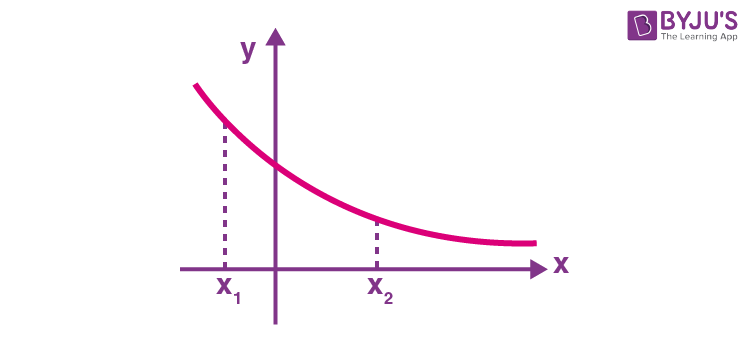In calculus, the derivative of a function is used to check whether the function is decreasing or increasing at any interval in a given domain. For a given function, y = F(x), if the value of y increases on increasing the value of x, then the function is known as an increasing function, and if the value of y decreases on increasing the value of x, then the function is known as a decreasing function.
Download Complete Chapter Notes of Applications of Derivatives
Download Now


In both of the given functions, x1 < x2 and F(x1) < F(x2), we can say it is an increasing function.
F(x) = e-x

In this function, value of y decreases on increasing the value of x as x1 < x2 and F(x1) < F(x2).
Increasing Function in Calculus
For a function, y = f(x) to be increasing (dy/dx) ≥ 0 for all such values of interval (a, b), and equality may hold for discrete values.
Example: Check whether y = x3 is an increasing or decreasing function.
Solution:
So, it is an increasing function.
Graphical Representation:

Decreasing Function in Calculus
For a function, y = f(x) to be monotonically decreasing (dy/dx) ≤ 0 for all such values of interval (a, b), and equality may hold for discrete values.
Example: Check whether the function y = -3x/4 + 7 is an increasing or decreasing function.
Differentiate the function with respect to x, and we get
So, we can say it is a decreasing function.

Solved Questions on Increasing and Decreasing Functions
Question 1: Prove that f(x) = x – sin(x) is an increasing function.
Solution: f(x) = x – sin(x)
(dy/dx) ≥ 0 as cos(x) having a value in the interval [-1, 1] and (dy/dx) = 0 for the discrete values of x and do not form an interval.
Hence, we can include this function as a monotonically increasing function.
Question 2: Prove that f(x) = cos x is decreasing function in [0, π].
Solution: f(x) = cos x
f’(x) = – sin x
As sin x is positive in the first and second quadrants, i.e., sin x ≥ 0 in [0, π], so we can say that
(dy/dx) = – (positive ) = negative ≤ 0
So, function f(x) = cos x is decreasing in [0, π].
Question 3: Prove that a polynomial with positive coefficients is increasing.
Solution: Let’s suppose polynomial is
So,
Derivate the above function with respect to x, and we have
As every coefficient is positive, and for a polynomial n ≥ 0.
So,
Therefore, we can say that a polynomial with positive coefficients is increasing.
Question 4: Discuss the increasing and decreasing nature of the function f(x) = x ln(x)
Solution:
Here, f(x) = x ln(x)
⇒ f’(x) = 1 + ln(x)
For a function to be increasing f’(x) > 0
⇒ 1 + ln(x) > 0
⇒ ln(x) > -1
⇒ ln(x) > – ln(e)
⇒ ln(x) > ln (e-1)
We know that ln(x) is increasing function, so for ln(x) > ln (e-1) to be hold
⇒ x > e-1
⇒ x > 1/e
Thus, function f(x) = x ln(x) to be increasing x ∈ (1/e, ∞) and for function f(x) = x ln(x) to be decreasing x ∈ (0, 1/e).
Question 5: Find the value of “a” if the function x3 – 6x2 + ax is increasing for all the values of x.
Solution:
Here f(x) = x3 – 6x2 + ax
⇒ f’(x) = 3x2 – 12x + a
For a function to be increasing f’(x) > 0
So, 3x2 – 12x + a > 0
⇒ 3(x2 – 4x + a/3) > 0
⇒ x2 – 4x + a/3 > 0
⇒ (x – 2)2 – 22 + a/3 > 0
⇒ (3(x – 2)2 – 12 + a)/3 > 0
⇒ 3(x – 2)2 – 12 + a > 0
We know that 3(x – 2)2 can’t be negative and having the minimum value 0 at x = 2
The minimum value of f’(x) is at x = 2
min. f’(x) = -12 + a
So for f’(x) > 0
⇒ -12 + a > 0
⇒ a > 12.
Video Lessons
Domain, Range, Period of Functions

Functions and Relations

Increasing and Decreasing Functions

Increasing and Decreasing Functions in One-Shot for JEE Mains 2023

Frequently Asked Questions
What do you mean by an increasing function?
For a function y = f(x), if the value of y increases on increasing the value of x, then the function is an increasing function.
Give an example of an increasing function.
The function f(x) = x3 is an example of an increasing function.
Give the condition to check that a function f(x) is increasing.
If f′(x) > 0 at each point in an interval I, then the function is said to be increasing on I.
What do you mean by a decreasing function?
For a function y = f(x), if the value of y decreases on increasing the value of x, then the function is a decreasing function.
Comments